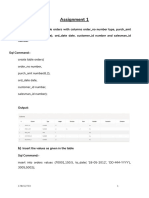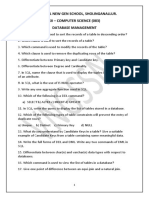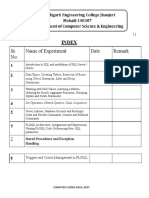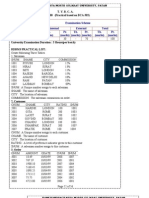0%(2)0% found this document useful (2 votes)
2K viewsSQL Case Study - Basic
This document provides a case study on analyzing customer transaction data for a retail store. It includes details on the available data tables - Customer, Transactions, and Product Category - and their relationships. It then lists 15 business questions to answer by writing SQL queries on the data. The questions cover understanding the data, analyzing trends in transactions, revenue, returns, and customer demographics over time.
Uploaded by
Hasan NaqviCopyright
© © All Rights Reserved
Available Formats
Download as PDF, TXT or read online on Scribd
0%(2)0% found this document useful (2 votes)
2K viewsSQL Case Study - Basic
This document provides a case study on analyzing customer transaction data for a retail store. It includes details on the available data tables - Customer, Transactions, and Product Category - and their relationships. It then lists 15 business questions to answer by writing SQL queries on the data. The questions cover understanding the data, analyzing trends in transactions, revenue, returns, and customer demographics over time.
Uploaded by
Hasan NaqviCopyright
© © All Rights Reserved
Available Formats
Download as PDF, TXT or read online on Scribd
You are on page 1/ 3
SQL CASE STUDY – Basic
Business Context
A retail store would like to understand customer behavior using their point of sale data
(POS).
Data Availability
The data set we will be using for this exercise comprises of 3 tables:
Customer: Customer demographics
Transactions: Customer transaction details
Product category: Product category and sub category information
The following diagram explains the relationship between tables.
Write SQL queries to get the required output for following business scenarios.
Notes:
Only one SQL query should be written for each question.
SQL queries should be written keeping in mind that you have read only access.
You can insert 1000 records only using the INSERT in one INSERT statement in MS SQL
Server. To insert more records, use INSERT statement again.
DATA PREPARATION AND UNDERSTANDING
1. What is the total number of rows in each of the 3 tables in the database?
2. What is the total number of transactions that have a return?
3. As you would have noticed, the dates provided across the datasets are not in a
correct format. As first steps, pls convert the date variables into valid date formats
before proceeding ahead.
4. What is the time range of the transaction data available for analysis? Show the
output in number of days, months and years simultaneously in different columns.
5. Which product category does the sub-category “DIY” belong to?
DATA ANALYSIS
1. Which channel is most frequently used for transactions?
2. What is the count of Male and Female customers in the database?
3. From which city do we have the maximum number of customers and how many?
4. How many sub-categories are there under the Books category?
5. What is the maximum quantity of products ever ordered?
6. What is the net total revenue generated in categories Electronics and Books?
7. How many customers have >10 transactions with us, excluding returns?
8. What is the combined revenue earned from the “Electronics” & “Clothing”
categories, from “Flagship stores”?
9. What is the total revenue generated from “Male” customers in “Electronics”
category? Output should display total revenue by prod sub-cat.
10. What is percentage of sales and returns by product sub category; display only top
5 sub categories in terms of sales?
11. For all customers aged between 25 to 35 years find what is the net total revenue
generated by these consumers in last 30 days of transactions from max transaction
date available in the data?
12. Which product category has seen the max value of returns in the last 3 months of
transactions?
13. Which store-type sells the maximum products; by value of sales amount and by
quantity sold?
14. What are the categories for which average revenue is above the overall average.
15. Find the average and total revenue by each subcategory for the categories which
are among top 5 categories in terms of quantity sold.
You might also like
- HTML Solved Practical 9TH Class 2023-2024No ratings yetHTML Solved Practical 9TH Class 2023-202414 pages
- LBS DCA (S) MS Office and Internet - Previous Question Paper December 2011100% (1)LBS DCA (S) MS Office and Internet - Previous Question Paper December 20111 page
- Chapter 15 - Relational Database Design Algorithms and Further DependenciesNo ratings yetChapter 15 - Relational Database Design Algorithms and Further Dependencies6 pages
- Practical Assignment SQL Assignment 1: Createtable Numeric Varchar Varchar Numeric Numeric Select FromNo ratings yetPractical Assignment SQL Assignment 1: Createtable Numeric Varchar Varchar Numeric Numeric Select From29 pages
- Office Automation Tools Class 11 MCQ - AnnotatedNo ratings yetOffice Automation Tools Class 11 MCQ - Annotated11 pages
- Data Visualization Using Spreadsheet - Theory Question BankNo ratings yetData Visualization Using Spreadsheet - Theory Question Bank6 pages
- Write An HTML Program To Create The TableNo ratings yetWrite An HTML Program To Create The Table48 pages
- 2.1 Structuring The Data, Computations and Program100% (1)2.1 Structuring The Data, Computations and Program27 pages
- General Register-Based CPU Organization-4No ratings yetGeneral Register-Based CPU Organization-411 pages
- kc4000 Week 8 Sub-Queries & Aggregation Part 1No ratings yetkc4000 Week 8 Sub-Queries & Aggregation Part 110 pages
- Reducing The Braking Distance of An SQL Query Engine: Carey@almaden. Ibm. Corn Kossmann@db, Fmi - Uni-Passau - deNo ratings yetReducing The Braking Distance of An SQL Query Engine: Carey@almaden. Ibm. Corn Kossmann@db, Fmi - Uni-Passau - de12 pages
- St. Xavier'S College B.SC Computer Science Hons (2nd Year) SQL Assignment SheetNo ratings yetSt. Xavier'S College B.SC Computer Science Hons (2nd Year) SQL Assignment Sheet3 pages
- Puter Programming For Beginners 1671803760No ratings yetPuter Programming For Beginners 1671803760123 pages
- CP7211 Advanced Databases Laboratory Manual75% (4)CP7211 Advanced Databases Laboratory Manual63 pages
- Practical SQL A Beginner s Guide to Storytelling with Data 1st Edition Anthony Debarros 2024 scribd download100% (1)Practical SQL A Beginner s Guide to Storytelling with Data 1st Edition Anthony Debarros 2024 scribd download65 pages
- (Bawal Magpalit NG Papel Pag Ngkamali) : Grade 12 - Oracle Database IDENTIFICATION (2 Points Each)No ratings yet(Bawal Magpalit NG Papel Pag Ngkamali) : Grade 12 - Oracle Database IDENTIFICATION (2 Points Each)3 pages
- Systems I Software Db2 PDF Performance DDS SQLNo ratings yetSystems I Software Db2 PDF Performance DDS SQL23 pages
- 13.join Dependencies and Fifth Normal FormNo ratings yet13.join Dependencies and Fifth Normal Form3 pages
- Oracle+Database +urgent +ORACLE+Initialization+or+Shutdown+in+Progress0% (1)Oracle+Database +urgent +ORACLE+Initialization+or+Shutdown+in+Progress28 pages

























































































